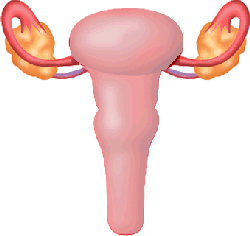The Female genital tract consists of the ovaries (which contain the egg cells and cells which produce hormones such as oestrogen and progesterone); the fallopian tubes (which provide a pathway for the egg between the ovary and the uterus, and where fertilisation usually occurs); the uterus, or womb (designed for the development of the foetus); the vagina (via which, under normal circumstances, sperm is introduced during intercourse to fertilise the egg, and via which the baby is born), and the vulva, which constitutes what’s called the “external genitalia” - the only part visible to most of us - consisting of two thin folds of skin called the labia minora, and two thicker, outer, hair-bearing folds called the labia majora. The clitoris is a button of tissue which sits at the apex of the vulva, where the labia minora join together, which becomes erect due to increased blood flow during sexual arousal, and is analogous to the male penis. The bottom of the vulva is separated from the anus by a firm block of tissue called the perineal body. The whole of the area between this at the bottom and the clitoris at the top is called the perineum (because it’s this which is around the baby - or neonate - at birth).


 - Tell me more about the ovaries
- Tell me more about the ovaries